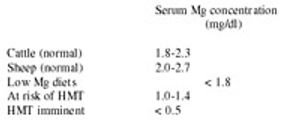
Anaplasmosis is a noncontagious, infectious, transmissible hemoparasitic disease of cattle.

Anaplasmosis is a noncontagious, infectious, transmissible hemoparasitic disease of cattle.

Several disease syndromes in cattle have been shown to be selenuim-responsive.

The number of gram negative bacteria proven or implicated to cause pinkeye (IBK) in cattle has expanded over the years.

Ruminants are uniquely susceptible to hypomagnesemic tetany (HMT) caused by a variety of factors.

Foot rot (interdigital phlegmon, foot abscess, foul-in-the-foot, infectious pododermatitis, interdigital necrobacillosis) is an infection of the interdigital tissue of cattle caused by Fusobacterium necrophorum and Prevotella melaninogenicus or Porphyromonas levii.

Copper deficiency occurs when the diet contains an abnormally low amount of copper (primary copper deficiency) or when copper absorption or metabolism is adversely affected (secondary copper deficiency).

Leptospirosis is a broad range of clinical and sub-clinical disease problems caused by a number of Leptospira serovars.

Published: August 1st 2009 | Updated:

Published: August 1st 2009 | Updated:

Published: August 1st 2009 | Updated:

Published: August 1st 2009 | Updated:

Published: August 1st 2009 | Updated:

Published: August 1st 2009 | Updated: